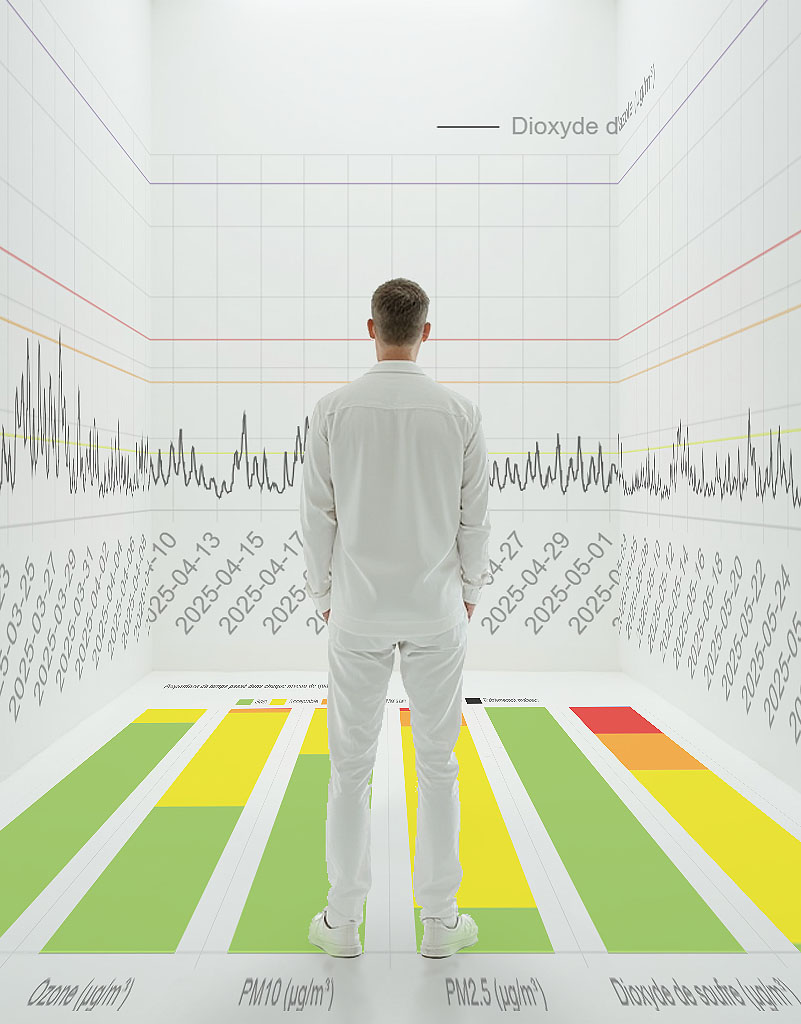Forest fire: what impact on respiratory health?

Southern France, California, Canada… Every year, as soon as summer begins, many regions are hit hard by flames. These wildfires, which may be accidental or intentional, are worsened by climate change and drought, increasing their frequency.
Beyond the threat to the safety of people and property, these fires also have a significant negative impact on the air quality we breathe.
More than 1 billion people worldwide1 are exposed to air pollution caused by wildfires for at least one day each year. This is particularly concerning, as the particles emitted by these fires (PM2.5) are among the most dangerous to human health.
So where do these fires come from? Why are they becoming more frequent? What are their effects on our respiratory health? A scientific study, published in May 2025 in the American journal *Science Advances*, has just validated the use of air purifiers as an effective solution to protect against these particles indoors. Let's take a closer look.
Wildfires: an increasingly frequent phenomenon
Wildfires: causes and definition
Not every fire outbreak qualifies as a wildfire. The French government's “Notre Environnement” website states that at least 0.5 hectares of forest must have burned for a fire to be considered a wildfire. The upper parts of the trees must also have been scorched. A wildfire results from three simultaneous elements: an ignition source (anything that can cause a spark or flame), fuel (that burns), and weather conditions that favor the spread of flames.
Weather conditions conducive to wildfires include high temperatures that increase plant transpiration, combined with relatively low humidity and insufficient water reserves in the soil. Vegetation that is thus dried out, or even dead, is more likely to catch fire. Wind can also be an aggravating factor and help spread the flames (ONF).
In 90% of cases, wildfires are caused by human activity. Fires may start due to professional activities (construction or agricultural work) or everyday actions (poorly extinguished cigarettes, barbecues, etc.)2.
Why are wildfires becoming more frequent?
While hot and dry weather conditions often trigger and fuel wildfires, climate change is a particularly aggravating factor. More specifically, according to the Reference Pathway for Climate Change Adaptation (TRACC), supported by the authorities and Météo France, the risk of wildfires is expected to increase in the coming years. By 2050, nearly the entire country will face wildfire risks. As a result, 50% of mainland forests will be exposed to fire risk, compared to one-third today.
In concrete terms, with rising temperatures, regions already affected are expected to see their fire season extended (by one to two months3), while other regions currently spared may become vulnerable to these phenomena. Wildfires have already seen a sharp increase in recent years. For instance, the government recorded 7,084 wildfires between January 1 and August 15, 2022, compared to an average of 4,000 per year from 2007 to 20184. INRAE estimates that major wildfires will increase from 7 to 10 per year by 2050, potentially reaching 20 by 2090 if greenhouse gas emissions and temperatures continue to rise5.

Source: Climate change fuels wildfire risks, INRAE [Online], 2025
The health impacts of wildfires
Very volatile and dangerous fine particles
With the increasing number of wildfires, it is essential to examine the effects of these fires on our respiratory health. Indeed, wildfires severely degrade air quality. For example, during the wildfire in Les Pennes-Mirabeau near Marseille in July 2025, the regional air quality agency (ATMO-SUD) reported that the air quality had never been worse in the region than during this major event6.
Beyond the danger they pose to people and property near the fire front, exposure to wildfire smoke extends far beyond the immediate vicinity. The smoke can affect populations hundreds or even thousands of kilometers away7 because the particles released by these fires can travel extremely long distances.

These effects concern us all, especially since these particles are particularly harmful to health. On one hand, they are among the smallest particles (PM2.5) and can penetrate deep into our respiratory and arterial systems. On the other hand, they are extremely toxic in composition, as they contain a much higher concentration of pollutants8. In addition, wildfire smoke contains high levels of carbon dioxide and nitrogen dioxide, both highly toxic to human health.
The effects of wildfires on our health
Exposure to wildfire smoke can cause numerous health problems such as eye and skin irritation, as well as the development of acute or chronic illnesses.
The European Climate and Health Observatory estimated that wildfires caused over 1,400 premature deaths in Europe in 2005. They also observed a 20-fold increase in respiratory illnesses following a series of wildfires around Vilnius, Lithuania in 2022. The observatory also highlighted strong correlations between the frequency of wildfires and the rise in pneumonia cases in Portugal.

While we are all affected by these risks, vulnerable individuals are particularly at risk from their consequences: children, the elderly, pregnant women, and people with pre-existing cardiovascular and/or respiratory conditions9.
Air purifiers as a solution to protect your respiratory health indoors
The benefits of using an air purifier indoors during a wildfire event
To protect themselves during a wildfire event, authorities generally advise people in nearby safe zones to stay indoors to avoid exposure to outdoor smoke.
Unfortunately, it is nearly impossible to fully shield oneself from wildfire fine particles, as they are among the smallest (PM2.5). Scientists estimate that on wildfire days, indoor pollution levels can be nearly three times higher than on normal days, even with windows closed10.
In this context, the study published in May in *Science Advances* demonstrated that using an air purifier indoors can have particularly beneficial effects on health11. An experiment conducted in California showed that using portable air purifiers helped reduce indoor PM2.5 particle concentrations. This had a positive effect by reducing the number of hospital admissions, which was lower than usual during a wildfire episode12.
The study also confirmed the relevance of using indoor air purifiers during wildfires to prevent health complications related to asthma. While installing an air purifier is not an absolute solution against wildfire smoke, it can still help mitigate harmful effects by removing toxic particles from the indoor air.
TEQOYA air purifiers: the natural and effective solution to protect yourself
To protect yourself, you can choose TEQOYA air purifiers, which use ozone-free ionization technology. This highly effective technology eliminates up to 99% of polluting particles — especially the finest ones like PM2.5, which are most present in wildfire smoke. Their efficiency is proven by tests carried out in independent laboratories. With no planned obsolescence, they come with a 10-year warranty.

Unlike some filtration technologies, such as HEPA filters that require regular replacement, our air purifiers only need occasional cleaning to maintain their effectiveness and performance. Energy-efficient, our TEQOYA T200 (for small rooms) and TEQOYA T450 (for large rooms) purifiers are completely silent.
Conclusion:
As wildfires become increasingly frequent due to climate change, the harmful effects of their smoke on health are now well established. Whether we live close to the fire line or farther away, we will all eventually face the negative health impacts of wildfire smoke. To protect ourselves, the use of indoor air purifiers has been scientifically validated as an effective solution to preserve our health. In any case, if you are near a wildfire, always follow the safety instructions issued by the authorities.
Sources:
- 1 7 8 9 10 11 12 The cost of clean air: Global disparities in reducing indoor wildfire-related PM2.5 exposure, Jing Li and Yifang Zhu (2025)
- 6Wildfire in Marseille: Atmosud warns of unprecedented air pollution levels, Made In Marseille, [Online], 2025
- Fire prevention in the face of climate change, ONF [Online], 2025
- 4Wildfires: What to expect and how to adapt?, Resource center for climate change adaptation, [Online], 2025
- 23INRAE warns about the consequences of climate change on wildfires, notre-environnement.gouv.fr, [Online], 2024
- Toxic wildfire pollution infiltrates homes of 1bn people a year, study finds, The Guardian [Online], 2025
- 5Climate change increases wildfire risks, INRAE [Online], 2025
- Wildfires, European Climate and Health Observatory [Online], 2025
Information on air quality and news from TEQOYA
How does an air ionizer work?
#Essential
Natural environments are rich in negative ions. This is precisely the principle on which the air ionizer is based on. However, do you know how this technology manages to capture the pollution particles contained in the indoor air to purify your home?
Are air purifiers effective against viruses, especially the coronavirus COVID-19
#Virus and microorganismes #L'essentiel
In December 2019, a respiratory virus of the Coronavirus family appeared in the Wuhan region of China and has now spread to all continents.
What is eco-responsibility?
#Essential
Purifying indoor air while protecting your health and the planet is possible! Say goodbye to filters and make way for negative ions: choose an eco-responsible air purifier that will easily reduce energy and resource consumption.



